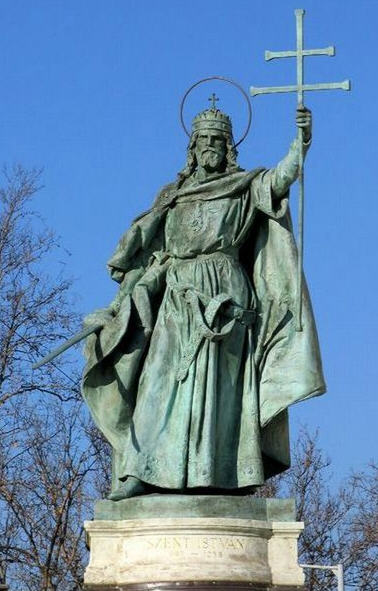
16 August
St Stephen of Hungary (c. 975-1038)
Born: Vajk, c. 975, Esztergom, Principality of Hungary
Died: 15 August 1038 (aged 62–63) Esztergom or Székesfehérvár, Kingdom of Hungary
Patron: Bricklayers; death of children; Hungary; kings; masons; stone masons; stonecutters..
Vaik, son of Geza, Duke of Hungary, was baptized about 985 by St. Adalbert of Prague who gave him the name of Stephen. He was chosen by God to bring his people to the Christian faith. With the assistance of monks from Burgundy, he established bishoprics, founded several monasteries and re-organized the whole life of the country. Pope Silvester II offered him the privilege of being crowned king and the ceremony took place on December 25, 1000. His great zeal for the spread of the Catholic faith earned him the title of apostolic king and apostle of Hungary. He died on August 15, 1038, the feast of the Assumption of our Lady, to whom he had consecrated his kingdom.
COLLECT PRAYER
Grant your Church, we pray, almighty God, that she may have Saint Stephen of Hungary, who fostered her growth while a king on earth, as her glorious defender in heaven. Through our Lord Jesus Christ, your Son, who lives and reigns with you in the unity of the Holy Spirit, God, for ever and ever.
Things to Do:
- A saint upon the throne, who besides being king was the apostle and father of his people! Reflect his spirit in your own family and toward your associates.
- Read more the history of Hungary. This site contains a wealth of information about the Hungarian Holy Crown, the Hand of St. Stephen and other information (Scroll down the page since the links don’t work). You can also visit this site for a virtual tour of Hungary.
St. Stephen of Hungary
St. Stephen was the first Christian king of Hungary. He was born in 975 at Gran, the son of Prince Geisa, and was baptized in 985 by St. Adalbert. While courting Gisela, the sister of Emperor St. Henry II, he was promised her hand in marriage provided that he remain firm in the Christian faith and lead the pagan Hungarians to Christianity. He kept his word though it cost him dearly. From the hands of Pope Sylvester II (999-1003) he received the royal crown and was solemnly enthroned at Gran on the feast of Mary’s Assumption, 1001. (The alleged bull of Pope Sylvester granting to Stephen and his successors the privilege of having the cross carried before them, like metropolitans, is now regarded as a seventeenth-century forgery.)
Stephen was one of the wisest princes of his time. His royal generosity is shown in the establishment of the archbishopric of Gran and ten Hungarian bishoprics, and in his love toward the poor. Because he visited them in their houses and washed their feet, his right hand has remained incorrupt. Great was his zeal in prayer and meditation. From his marriage came a saintly son, the devout Emeric, an angel of purity, who died seven years before his father. By prayer and fasting Stephen sought the conversion of all Hungary; rightfully is he called the apostle of his nation. He chose the Mother of God as the patroness of Hungary.
— Excerpted from The Church’s Year of Grace, Pius Parsch
Source: Catholic Culture